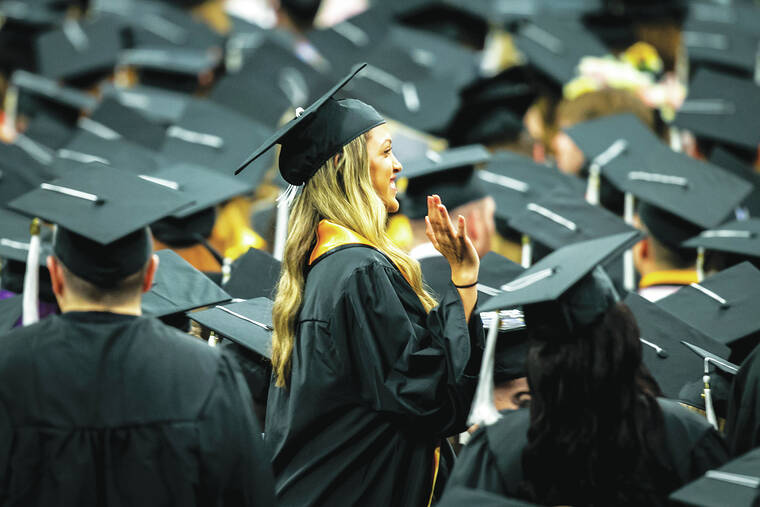The US has approved $42 billion in loan forgiveness for public service workers. Here’s what to know
The U.S. has approved more than $42 billion in federal student loan debt forgiveness for more than 615,000 borrowers in the past 18 months as part of a program aimed at getting more people to work in public service jobs, the U.S. Department of Education said this week.
The Public Service Loan Forgiveness program is open to teachers, librarians, nurses, public interest lawyers, military members and other public workers. It cancels a borrower’s remaining student debt after 10 years of public interest work, or 120 monthly payments.
The program is separate from President Joe Biden’s student debt relief plan, which would wipe away or reduce loans for millions of borrowers regardless of what field they work in. The U.S. Supreme Court is currently considering whether that plan can go ahead.
The Public Service Loan Forgiveness program, known as PSLF, was launched in 2007, but stringent rules meant that more than 90% of applicants were rejected, the Department of Education said in 2019.
In October 2021, the government temporarily relaxed the requirements, making it easier for people to apply and be approved. Those relaxed requirements ended in October 2022. However, borrowers who want to increase their payment count have another opportunity to do so. They can apply for the one-time account adjustment until the end of the year.
Through the one-time account adjustment, borrowers with direct loans through the William D. Ford program will have similar benefits to those that were available under the limited PSLF waiver. Borrowers who do not have direct loans can consolidate and receive PSLF credit for prior payments as part of this adjustment, as long as they submit a consolidation application by the end of 2023.
One of the people who benefited from the PSLF waiver was Beth Bourdon, an assistant public defender in Orlando, Florida.
Bourdon had about $57,000 of student loans forgiven in February 2022. Previously, because her loans had been acquired through the Family Federal Education Loan Program, Bourdon didn’t qualify for relief. But when the waiver took effect in October 2021, she successfully applied.
“I kept checking and re-checking the site, and one day I went and the balance was zero,” Bourdon said.
With the exception of one two-year period, Bourdon has worked in public interest law since 2005. She said she made payments of about $417 every month from June 2008 to October 2021, when she consolidated her loans and applied for PSLF.
Bourdon said the cancellation gives her “breathing room.”
She added that she personally talked about 10 people she knows through the process of applying for forgiveness via the waiver, and that several have already received cancellation.
Starting July 1 of this year, the Education Department will implement changes designed to make the PSLF application process easier.
Here’s what you need to know if you want to apply:
Who qualifies?
If you are or were previously employed at least 30 hours per week with the following types of organizations, you qualify:
— Government organizations at any level (U.S. federal, state, local, or tribal). This includes the U.S. military, all work in public education, and full-time volunteer work with AmeriCorps and the Peace Corps.
— Any not-for-profit organization that is tax-exempt under Section 501(c)(3) of the Internal Revenue Code.
— If you work for a not-for-profit organization that is not tax-exempt, you may still qualify for PSLF if the organization provides certain types of qualifying public services.
To demonstrate that your job in public service qualifies you for forgiveness, you’ll file an employer certification form with your servicer, listing jobs you’ve held.
You must have direct loans or consolidate other federal student loans into a direct loan. You must also make 120 qualifying payments or 10 years of payments.
Which student loans are eligible?
Any federal student loan received under the William D. Ford Federal Direct Loan program is eligible.
If you have either a Federal Family Education Loan (FFEL) or a Federal Perkins Loan, you’ll need to consolidate those into direct loans with your servicer. Payments made on these loans before you consolidated them do not count as qualifying PSLF payments.
How can I apply?
You can apply to the program using the PSLF help tool. If you want to do it manually, you can print and mail a PSLF form.
What about the payment pause?
Student loan payments are currently paused because of the COVID pandemic.
Payments are set to resume, along with the accrual of interest, 60 days after the current Supreme Court case about student loan forgiveness is resolved. If the case hasn’t been resolved by June 30, payments will start 60 days after that.
Borrowers will get credit toward PSLF for payments they would have made during the pause as long as they meet all other qualifications for the program, according to the Education Department.
For the qualifying payments to show in your account, you must submit a PSLF form that certifies your employment during the pause.
Who can I contact if I have questions?
If you have a specific question about your application, it’s best to call or email a representative.
For general questions about student loans, the Federal Student Aid Information Center (FSAIC) hosts a contact center that allows borrowers to live chat, call or email.


